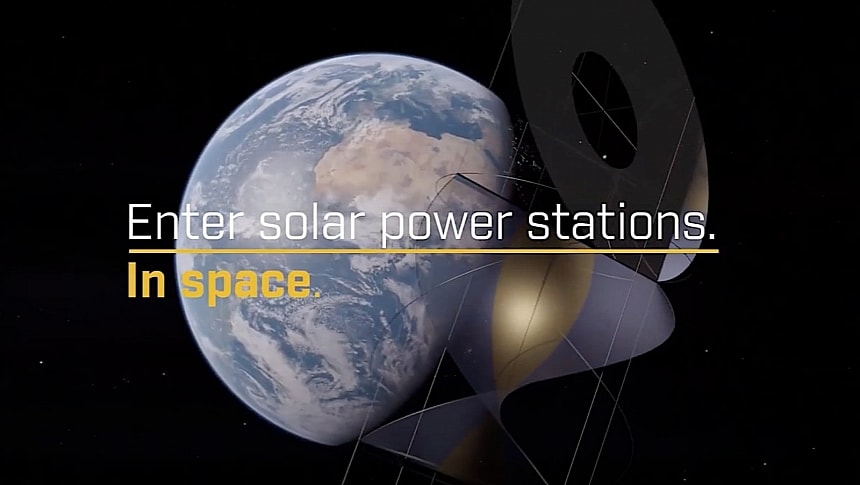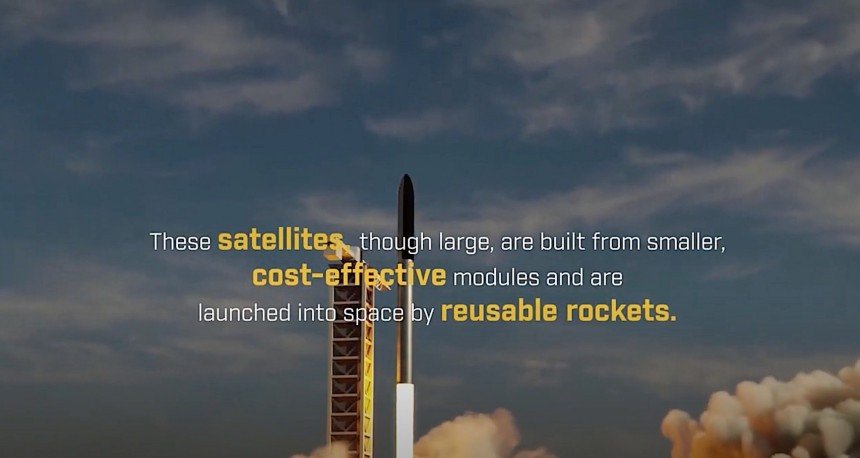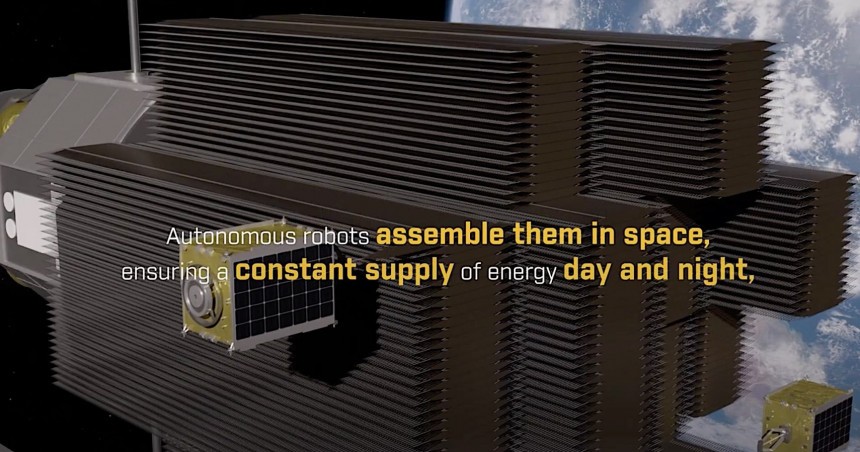The harvesting of solar power is one of the most effective ways to satisfy our energy needs. It's (relatively) cheap and easy to generate, making it an ideal weapon in our fight to reduce our dependence on fossil fuels. But solar power has one major drawback – because of Earth's rotation, and sometimes even on account of weather, it's not always available.
That's why for several years now humans have been dreaming about creating solar power stations in space. And I'm not talking about the ones already up there, in the form of solar panels that power the International Space Station (ISS) and the satellites orbiting our planet. I'm talking about solar power stations that could harness the energy of the Sun from where it's always available, and deliver it back to Earth for our needs.
The concept might forever change the way we get our power. It does need to overcome several major hurdles, though, with one of the biggest being how to beam the captured power to the surface of the planet.
Harnessing solar power in space will naturally be done with satellites acting as solar power stations. They will, however, need to be a bit more evolved than traditional satellites, because in order for them to capture sunlight and deliver it to the surface, they'll have to point both at the Sun and at the Earth at the same time.
This is a problem that, in some sense, is bigger than that of transferring power wirelessly, and so far involved a large rotating joint that complicated the design of satellites. It's an issue that a company called Space Solar claims to be on track to solve.
Space Solar is a British startup that in a relatively short period of time managed to attract over 80 organizations, including the UK government, into a project called the Space Energy Initiative – an effort meant to make solar power generation in space for use on Earth a reality.
The company managed to do that thanks to what seems to be a revolutionary way of keeping satellites oriented in both directions at the same time.
The tech is called Harrier, and it replaces the rotating joint with an undisclosed kind of design that "enables the transmission of power in all directions without the need for moving parts."
The Harrier is meant to rotate the satellite's beam 360 degrees, meaning it will always be able to capture sunlight and send it back to Earth. It is, according to Space Solar, "the world’s first 360° wireless power transmission system."
The technology is not here yet in full-size form, but the company recently put a scaled-down technology demonstrator to the test, in a series of procedures conducted at the Queen's University in Belfast. It was not a simple test, but rather the reaching of a "historic milestone."
For the testing campaign, Space Solar used a 1.6 feet (0.5-meter) diameter version of the Harrier, which proved it could steer the energy beam in all directions, ensuring a continuous power supply regardless of the satellite's orientation.
On top of that, the team also put through its paces something called the Retrodirective Control System – a system meant to ensure the energy sent from space can be accurately pointed at a receiver, eliminating losses and ensuring the safety of the process. Lastly, the tests also looked at how wireless power beaming will work, down to the form of the beam.
The Harrier will eventually become a key component in a series of satellites Space Solar calls CASSIOPeiA. For uses in space, it will grow from the tiny size it was tested into a staggering diameter of one mile (1.7 km). In this size, it should be capable of delivering GW-scale power.
The entire process of harnessing energy in space will work a bit like this. A fleet of Harrier-equipped CASSIOPeiA satellites will be launched to geostationary orbits outside Earth's shadow and assembled on-site by autonomous robots. Once operational, the network will begin its work.
Large solar panels and a series of mirrors will be used to capture the sunlight, which will then be transformed into high-frequency radio waves that will be beamed down to the planet below. The radio waves are collected by antennas on the ground and transformed once more, this time into electricity.
Space Solar says each of the satellites in the network generates as much power as a traditional station. Those worried that the radio waves raining down from space could somehow be harmful to living creatures here on Earth are assured the waves pose no danger.
It was probably enough for many of you to read about the orbital autonomous robots that will assemble the satellites to realize that the Space Solar idea will take a lot of years to become a reality.
The company hasn't set a deadline for the launch of the first CASSIOPeiA, but it did say whatever results from its work with the Harrier could very well have terrestrial applications as well.
The idea does have a lot of potential, though, and it certainly deserves further efforts. After all, who wouldn't like to have access to clean power without interruption?
The concept might forever change the way we get our power. It does need to overcome several major hurdles, though, with one of the biggest being how to beam the captured power to the surface of the planet.
Harnessing solar power in space will naturally be done with satellites acting as solar power stations. They will, however, need to be a bit more evolved than traditional satellites, because in order for them to capture sunlight and deliver it to the surface, they'll have to point both at the Sun and at the Earth at the same time.
This is a problem that, in some sense, is bigger than that of transferring power wirelessly, and so far involved a large rotating joint that complicated the design of satellites. It's an issue that a company called Space Solar claims to be on track to solve.
Space Solar is a British startup that in a relatively short period of time managed to attract over 80 organizations, including the UK government, into a project called the Space Energy Initiative – an effort meant to make solar power generation in space for use on Earth a reality.
The tech is called Harrier, and it replaces the rotating joint with an undisclosed kind of design that "enables the transmission of power in all directions without the need for moving parts."
The Harrier is meant to rotate the satellite's beam 360 degrees, meaning it will always be able to capture sunlight and send it back to Earth. It is, according to Space Solar, "the world’s first 360° wireless power transmission system."
The technology is not here yet in full-size form, but the company recently put a scaled-down technology demonstrator to the test, in a series of procedures conducted at the Queen's University in Belfast. It was not a simple test, but rather the reaching of a "historic milestone."
For the testing campaign, Space Solar used a 1.6 feet (0.5-meter) diameter version of the Harrier, which proved it could steer the energy beam in all directions, ensuring a continuous power supply regardless of the satellite's orientation.
On top of that, the team also put through its paces something called the Retrodirective Control System – a system meant to ensure the energy sent from space can be accurately pointed at a receiver, eliminating losses and ensuring the safety of the process. Lastly, the tests also looked at how wireless power beaming will work, down to the form of the beam.
The entire process of harnessing energy in space will work a bit like this. A fleet of Harrier-equipped CASSIOPeiA satellites will be launched to geostationary orbits outside Earth's shadow and assembled on-site by autonomous robots. Once operational, the network will begin its work.
Large solar panels and a series of mirrors will be used to capture the sunlight, which will then be transformed into high-frequency radio waves that will be beamed down to the planet below. The radio waves are collected by antennas on the ground and transformed once more, this time into electricity.
Space Solar says each of the satellites in the network generates as much power as a traditional station. Those worried that the radio waves raining down from space could somehow be harmful to living creatures here on Earth are assured the waves pose no danger.
It was probably enough for many of you to read about the orbital autonomous robots that will assemble the satellites to realize that the Space Solar idea will take a lot of years to become a reality.
The company hasn't set a deadline for the launch of the first CASSIOPeiA, but it did say whatever results from its work with the Harrier could very well have terrestrial applications as well.
The idea does have a lot of potential, though, and it certainly deserves further efforts. After all, who wouldn't like to have access to clean power without interruption?












